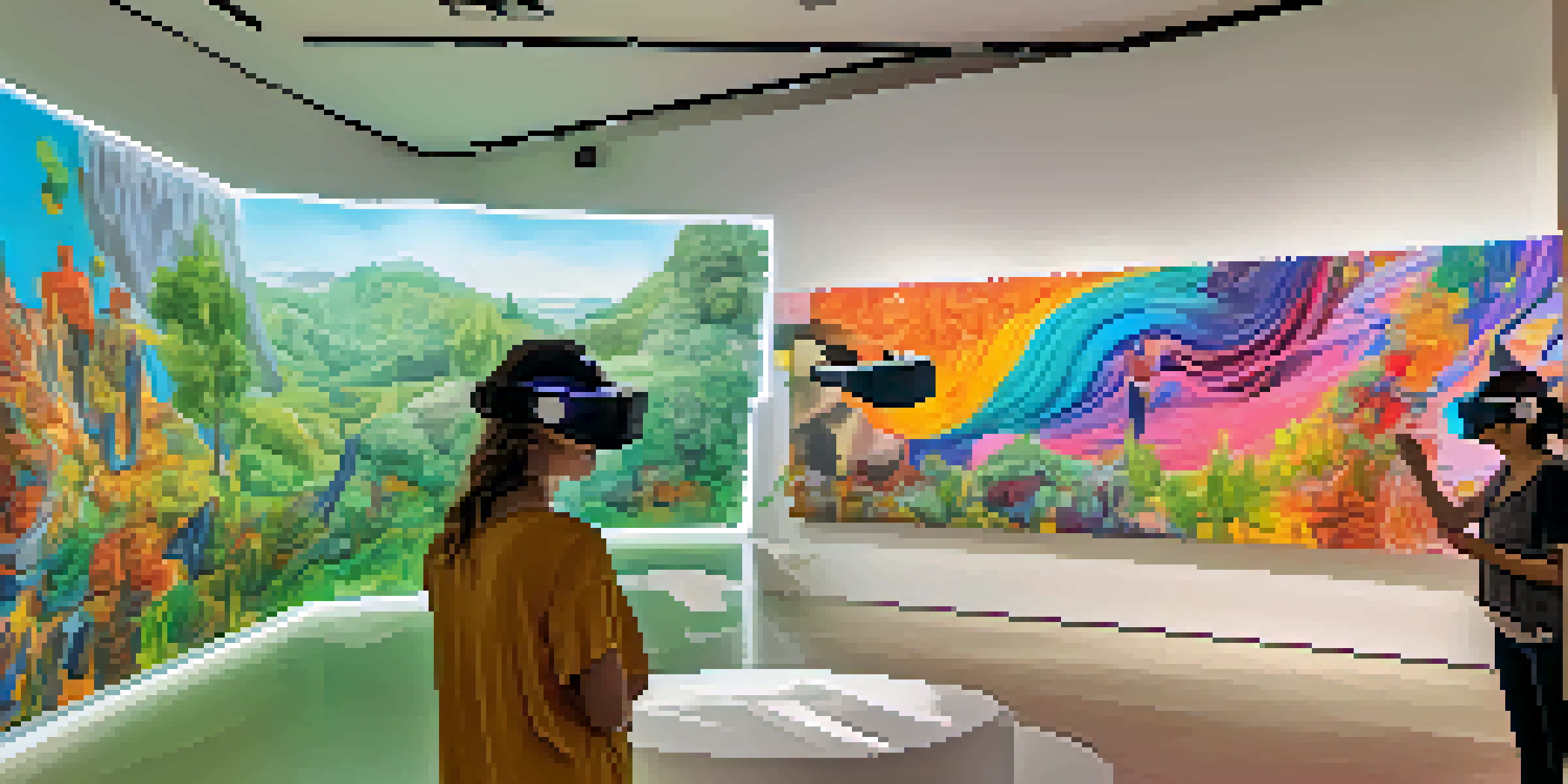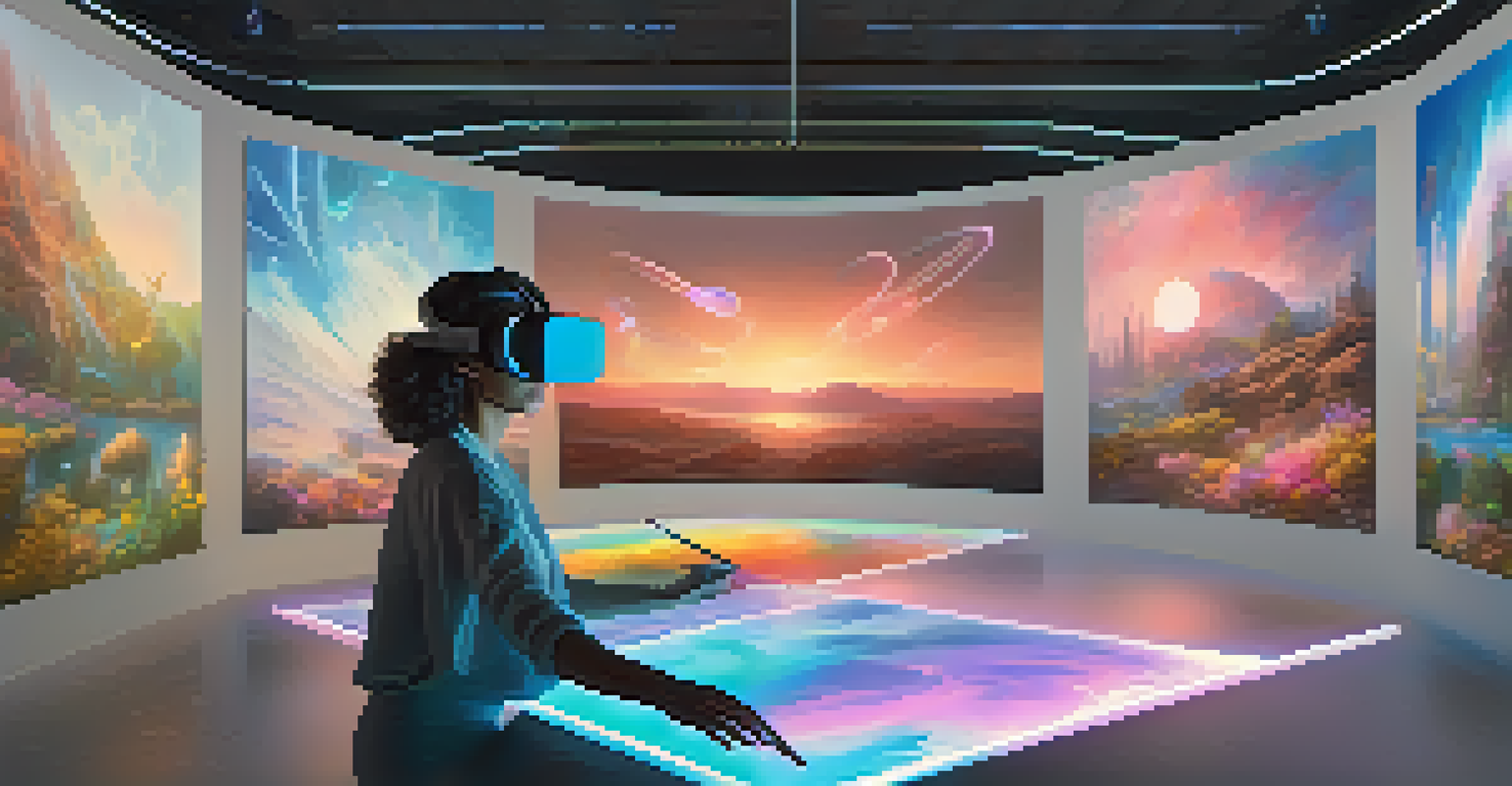The Impact of Virtual Reality on Contemporary Art Creation

Understanding Virtual Reality in the Art World
Virtual reality (VR) is a technology that immerses users in a 3D environment, allowing them to interact with digital spaces. In the art world, this means artists can create and experience their work in entirely new dimensions. Imagine stepping inside a painting or sculpture, experiencing it from all angles, rather than viewing it from a fixed perspective. This transformative experience is reshaping how we think about and engage with art.
Virtual reality is the first truly immersive medium that allows us to experience art in a way that transcends the physical world.
As VR becomes more accessible, contemporary artists are increasingly using it as a medium for their creations. This technology opens up endless possibilities for storytelling and expression, inviting audiences to participate rather than just observe. For example, an artist might create a virtual gallery where viewers can navigate through different rooms, each representing a unique theme or concept. This level of interactivity adds depth to the viewer's experience.
Moreover, VR allows for a blend of various art forms, such as painting, sculpture, and performance art, into one cohesive experience. Artists can incorporate sound, movement, and even audience participation, creating a multi-sensory environment. This intersection of technology and creativity is pushing the boundaries of traditional art, making it more inclusive and engaging for diverse audiences.
The Collaborative Nature of VR Art Creation
One of the most exciting aspects of VR in art is its collaborative potential. Artists can work together in virtual spaces, regardless of their physical location, breaking down geographical barriers. This global collaboration fosters a rich exchange of ideas, styles, and techniques, resulting in innovative artworks that reflect diverse perspectives. Imagine a painter in Paris collaborating with a sculptor in Tokyo, creating a shared masterpiece that combines their unique talents.

This collaborative spirit is further amplified by VR platforms that allow for real-time interaction and co-creation. Artists can invite others to join them in the virtual space, enabling spontaneous creativity and experimentation. This not only enriches the artistic process but also builds a sense of community among creators. Such environments encourage artists to push their boundaries and explore new possibilities together.
VR Transforms Art Engagement
Virtual reality immerses audiences in art, allowing them to actively participate and experience artworks in innovative ways.
Additionally, these collaborations often extend beyond just artists to include technologists, curators, and audiences. By involving different stakeholders in the creative process, the resulting artwork can resonate on multiple levels, appealing to a broader audience. This interconnectedness emphasizes the importance of collaboration in contemporary art, showcasing how VR is not just a tool but a catalyst for collective creativity.
Enhancing Audience Engagement Through VR
Virtual reality has the incredible ability to enhance audience engagement in art. Traditional galleries often present art in a static form, where viewers passively observe. In contrast, VR allows audiences to step inside the artwork, actively participating in the experience. This immersive quality can evoke emotions and reactions that traditional art forms may struggle to achieve, making the viewer a part of the narrative.
The future belongs to those who see possibilities before they become obvious.
For instance, a VR art installation could simulate a journey through an artist's mind, allowing viewers to explore their thoughts and inspirations. This kind of engagement fosters a deeper connection between the audience and the artwork, encouraging reflection and discussion. The experience becomes personal, inviting viewers to interpret and interact with the art in ways that resonate with them individually.
Moreover, VR can make art accessible to those who may not be able to visit galleries in person, such as individuals with disabilities or those living in remote areas. Virtual exhibitions can reach a global audience, democratizing access to art and culture. This shift not only broadens the audience base but also enriches the conversation around art, allowing for diverse voices and interpretations to be heard.
Redefining Artistic Boundaries with New Mediums
The introduction of VR has led many artists to redefine what art can be, challenging traditional boundaries. Artists are no longer limited to canvas or sculpture; they can create entire worlds that can be explored and experienced. This freedom encourages experimentation and innovation, as creators push the limits of their imagination. The concept of 'art' expands, inviting new interpretations and forms.
For example, artists like Jon Rafman have utilized virtual environments to explore themes of nostalgia and memory, crafting experiences that reflect our digital lives. By transforming static concepts into dynamic, interactive pieces, these artists highlight the fluidity of contemporary art. As a result, audiences are encouraged to engage with art in unconventional ways, sparking dialogue around the evolving definition of creativity.
Collaboration Across Boundaries
VR enables artists from different parts of the world to collaborate in real-time, fostering a rich exchange of ideas and creativity.
Additionally, the use of VR can lead to the creation of art that exists solely within digital realms. These digital-only artworks challenge traditional notions of ownership and display, prompting questions about how we value art in the digital age. As artists continue to explore these boundaries, they pave the way for future generations to innovate and redefine the landscape of contemporary art.
The Role of Technology in Artistic Innovation
Technology plays a vital role in shaping contemporary art, and VR is at the forefront of this evolution. This medium not only facilitates new forms of expression but also encourages artists to integrate technology into their creative processes. By embracing technological advancements, artists can explore complex themes and ideas that might have been difficult to convey through traditional methods. For instance, the combination of VR with artificial intelligence opens up new avenues for creativity and collaboration.
The integration of technology also allows for the documentation and sharing of artistic processes in real-time. Artists can livestream their VR creations, offering audiences a behind-the-scenes look at their work. This transparency fosters a deeper appreciation for the artistic journey, as viewers witness the challenges and triumphs of creation. Such engagement can inspire aspiring artists and art enthusiasts alike.
Moreover, the impact of technology extends beyond the artist’s studio. Museums and galleries are increasingly adopting VR to enhance exhibitions, offering visitors interactive experiences that complement traditional displays. This integration shows how technology can enrich our understanding of art, bridging the gap between the creator and the audience while encouraging innovative approaches to curatorial practices.
Challenges and Limitations of VR in Art
While the potential of VR in art is vast, it is not without its challenges. One significant barrier is the accessibility of the technology itself. Not everyone has the means to access VR headsets or the necessary hardware, which can limit who can experience these innovative works. This disparity raises questions about inclusivity in the art world and whether VR will inadvertently create new forms of elitism.
Additionally, as with any new medium, there is a learning curve for artists. Many creators may find it challenging to adapt their skills to this digital format, particularly those who have spent years perfecting traditional techniques. This transition can be daunting, leading some to hesitate in exploring VR as a viable artistic medium. However, as more resources and training become available, this barrier is gradually diminishing.
Redefining Artistic Possibilities
The use of VR encourages artists to challenge traditional notions of art, creating new forms and experiences that expand the definition of creativity.
Furthermore, the ephemeral nature of digital art raises concerns about preservation and longevity. Unlike physical artworks that can be displayed for years, VR experiences may require ongoing maintenance and updates to remain accessible. This challenge emphasizes the importance of developing strategies for preserving digital art, ensuring that future generations can appreciate and learn from these contemporary works.
The Future of Virtual Reality in Contemporary Art
Looking ahead, the future of virtual reality in contemporary art is filled with possibilities. As technology continues to advance, we can expect to see even more innovative uses of VR that push the boundaries of creativity. Artists will likely explore new narratives and interactive experiences, making art more immersive and engaging than ever before. This evolution could lead to entirely new art forms that we can't yet imagine.
Additionally, as awareness of VR art grows, so too will the demand for unique experiences in galleries and museums. Institutions may begin to prioritize digital art exhibitions, integrating VR as a standard component of their offerings. This shift could help validate VR as a legitimate art form, encouraging more artists to experiment with this medium and further enriching the contemporary art landscape.

Ultimately, the intersection of technology and art will continue to inspire new generations of creators. As VR becomes more mainstream, it has the potential to transform how we experience, create, and appreciate art, fostering a vibrant dialogue about its role in society. The journey of virtual reality in contemporary art is just beginning, and its impact will undoubtedly shape the future of creative expression.